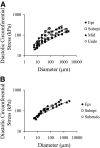Wall thickness of coronary vessels varies transmurally in the LV but not the RV: implications for local stress distribution
- PMID: 19482964
- PMCID: PMC2724217
- DOI: 10.1152/ajpheart.01136.2008
Wall thickness of coronary vessels varies transmurally in the LV but not the RV: implications for local stress distribution
Abstract
Since the right and left ventricles (RV and LV) function under different loading conditions, it is not surprising that they differ in their mechanics (intramyocardial pressure), structure, and metabolism; such differences may also contribute to differences in the coronary vessel wall. Our hypothesis is that intima-media thickness (IMT), IMT-to-radius (IMT-to-R) ratio, and vessel wall stress vary transmurally in the LV, much more than in the RV. Five normal Yorkshire swine were used in this study. The major coronary arteries were cannulated through the aorta and perfusion fixed with 6.25% glutaraldehyde and casted with a catalyzed silicone-elastomer solution. Arterial and venous vessels were obtained from different transmural locations of the RV and LV, processed for histological analysis, and measured with an imaging software. A larger transmural gradient was found for IMT, IMT-to-R ratio, and diastolic circumferential stress in vessels from the LV than the nearly zero transmural slope in the RV. The IMT of arterial vessels in the LV showed a slope of 0.7 +/- 0.5 compared with 0.3 +/- 0.3 of arterial vessels in the RV (P <or= 0.05). The slope for venous vessels in the LV was 0.14 +/- 0.14 vs. 0.06 +/- 0.05 in the RV. The present data reflect the local structure-function relation, where the significant gradient in intramyocardial pressure in the LV is associated with a significant gradient of IMT and IMT-to-R ratio, unlike the RV. This has important implications for local adaptation of transmural loading on the vessel wall and vascular remodeling when the loading is perturbed in cardiac hypertrophy or heart failure.
Figures





Similar articles
-
Right ventricular hypertrophy causes impairment of left ventricular diastolic function in the rat.Basic Res Cardiol. 2007 Jan;102(1):19-27. doi: 10.1007/s00395-006-0620-5. Epub 2006 Sep 1. Basic Res Cardiol. 2007. PMID: 16944361
-
Pressure-flow characteristics in the right and left ventricular perfusion territories of the right coronary artery in swine.Pflugers Arch. 1991 Dec;419(6):622-8. doi: 10.1007/BF00370305. Pflugers Arch. 1991. PMID: 1788057
-
Effects of coronary venous pressure on left ventricular diastolic distensibility.Circ Res. 1990 Oct;67(4):923-32. doi: 10.1161/01.res.67.4.923. Circ Res. 1990. PMID: 2208615
-
Coronary flow regulation in the fetal sheep.Am J Physiol. 1999 Nov;277(5):R1249-60. doi: 10.1152/ajpregu.1999.277.5.R1249. Am J Physiol. 1999. PMID: 10564194 Review.
-
The dynamic structure of arterioles.Basic Clin Pharmacol Toxicol. 2012 Jan;110(1):5-11. doi: 10.1111/j.1742-7843.2011.00813.x. Epub 2011 Nov 9. Basic Clin Pharmacol Toxicol. 2012. PMID: 21989114 Free PMC article. Review.
Cited by
-
Coronary Blood Flow Is Increased in RV Hypertrophy, but the Shape of Normalized Waves Is Preserved Throughout the Arterial Tree.Front Physiol. 2018 May 31;9:675. doi: 10.3389/fphys.2018.00675. eCollection 2018. Front Physiol. 2018. PMID: 29904356 Free PMC article.
-
miR-21 normalizes vascular smooth muscle proliferation and improves coronary collateral growth in metabolic syndrome.FASEB J. 2014 Sep;28(9):4088-99. doi: 10.1096/fj.14-251223. Epub 2014 Jun 5. FASEB J. 2014. PMID: 24903275 Free PMC article.
-
Why is the subendocardium more vulnerable to ischemia? A new paradigm.Am J Physiol Heart Circ Physiol. 2011 Mar;300(3):H1090-100. doi: 10.1152/ajpheart.00473.2010. Epub 2010 Dec 17. Am J Physiol Heart Circ Physiol. 2011. PMID: 21169398 Free PMC article.
-
Theoretical models for coronary vascular biomechanics: progress & challenges.Prog Biophys Mol Biol. 2011 Jan;104(1-3):49-76. doi: 10.1016/j.pbiomolbio.2010.10.001. Epub 2010 Oct 30. Prog Biophys Mol Biol. 2011. PMID: 21040741 Free PMC article. Review.
-
miR-21-mediated decreased neutrophil apoptosis is a determinant of impaired coronary collateral growth in metabolic syndrome.Am J Physiol Heart Circ Physiol. 2015 Jun 1;308(11):H1323-35. doi: 10.1152/ajpheart.00654.2014. Epub 2015 Apr 3. Am J Physiol Heart Circ Physiol. 2015. PMID: 25840830 Free PMC article.
References
-
- Anderson PG, Bishop SP, Digerness SB. Vascular remodeling and improvement of coronary reserve after hydralazine treatment in spontaneously hypertensive rats. Circ Res 64: 1127–1136, 1989. - PubMed
-
- Anrep GV, Cruickshank EWH, Downing AC. The coronary circulation in relation to the cardiac cycle. Heart 14: 111–133, 1927.
-
- Archie JP Determinants of regional intramyocardial pressures. J Surg Res 14: 338–346, 1973. - PubMed
-
- Beltrami CA, Finato N, Rocco M, Feruglio GA, Puricelli C, Cigola E, Quaini F, Sonnenblick EH, Olivetti G, Anversa P. Structural basis of end-stage failure in ischemic cardiomyopathy in humans. Circulation 89: 151–163, 1994. - PubMed
-
- Breisch EA, White FC, Bloor CM. Myocardial characteristics of pressure-overload hypertrophy. A structural and functional study. Lab Invest 51: 333–342, 1984. - PubMed
Publication types
MeSH terms
Grants and funding
LinkOut - more resources
Full Text Sources

